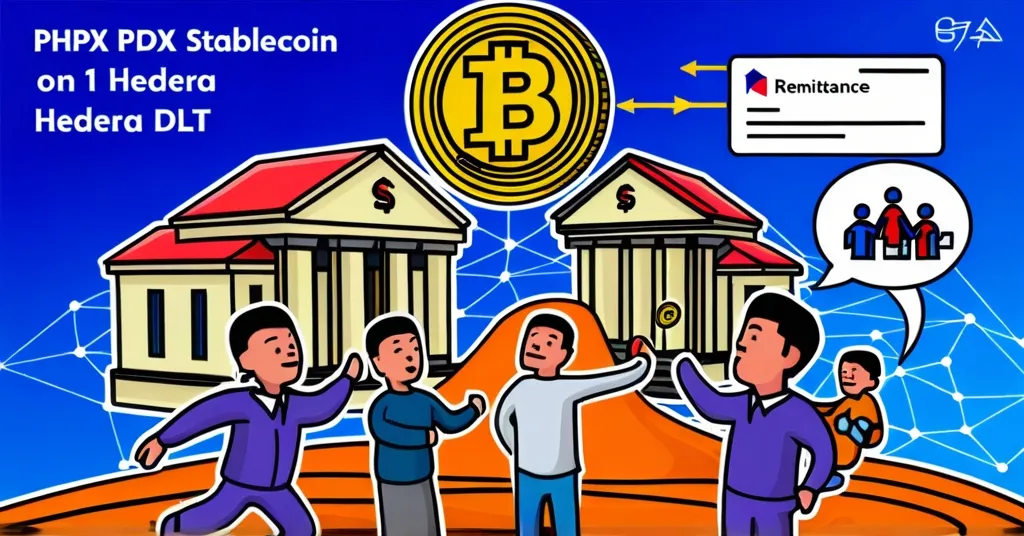Filipino Banks Launch PHPX Stablecoin on Hedera DLT for Remittance Revolution

Filipino Banks Launch PHPX Stablecoin on Hedera DLT to Revolutionize Remittances
Four Filipino banks are set to launch PHPX, a multi-bank peso stablecoin, on the Hedera Distributed Ledger Technology (DLT) network later this year. Initiated by JUST Finance, this innovative stablecoin aims to improve cross-border payments and remittances, offering Filipinos abroad more control over their finances.
- Four Filipino banks launch PHPX on Hedera DLT
- Aimed at enhancing remittances and cross-border payments
- Compliance with Basel and MiCA regulations
UnionBank of the Philippines, Rizal Commercial Banking, Cantilan Bank, and the Rural Bank of Guinobatan are driving this project. PHPX is a stablecoin pegged to the Philippine peso, designed to integrate seamlessly with existing financial systems while harnessing the benefits of blockchain technology. The stablecoin will operate on the Hedera DLT network, selected for its compliance with international banking regulations (Basel) and the European Union’s Markets in Crypto-Assets (MiCA) regulations, which are essential for the project’s success.
The Philippines, ranking as the fourth largest recipient of remittances globally, received $40 billion last year, equivalent to about 10% of the nation’s GDP. PHPX aims to streamline the remittance process, enabling Filipinos abroad to send money home more efficiently and with greater autonomy over their funds. Imagine Maria, working hard in Dubai, who can now transfer her earnings to her family in Manila with the ease of sending a text message — that’s the promise of PHPX.
The reserves for PHPX will be held in segregated bank trust accounts, primarily invested in government bonds to ensure stability and security. This approach not only meets regulatory standards but also instills confidence in users. Additionally, plans are in place for a regulatory-compliant multi-currency stablecoin exchange to further facilitate cross-border payments.
John Januszczak, CEO of UBX, UnionBank’s subsidiary, highlighted the need for a publicly exchangeable stablecoin, stating,
“We need to create something that is publicly exchangeable, so that we can support use cases outside of our own closed loop ecosystem.”
This vision aims to extend beyond traditional banking limits and fully leverage blockchain’s potential.
However, navigating regulatory landscapes presents its challenges. David Inderias, CEO of JUST Finance, noted the potential costs if PHPX were to be classified under a less favorable regulatory category, saying,
“If a bank stablecoin is classified with other cryptocurrencies (Group 2), it could get expensive for the banks to hold them.”
This underscores the delicate balance between innovation and compliance that the banks must maintain.
Hedera DLT was chosen for its hashgraph consensus algorithm, which offers high security and efficiency. The network’s services, including Smart Contracts, Consensus, and Token Services, will support the operations of PHPX, ensuring smooth transactions and governance. Hedera’s decentralized governance model, managed by a council of 39 leading global organizations, adds a layer of stability and long-term viability to the project.
This initiative aligns with a global trend towards the adoption of stablecoins for remittances and cross-border payments. While the Philippines has seen other initiatives, such as Circle’s partnership with Coins.ph using USDC, PHPX’s multi-bank approach and focus on regulatory compliance set it apart. It promises a robust and secure platform for users, but the real test will be in navigating the regulatory waters — a dance that requires knowing the steps and not stepping on any toes!
While optimism for PHPX is high, a realistic approach is crucial. The project’s success depends on its ability to adapt to regulatory changes and maintain user trust. Like any financial innovation, there are risks, from technological challenges to potential shifts in regulatory frameworks. Yet, the potential benefits for Filipinos abroad and the broader financial ecosystem are significant, showcasing a future where blockchain technology could be central to everyday transactions.
Playing devil’s advocate, one might question whether stablecoins can truly revolutionize remittances or if they merely add another layer of complexity. Centralization concerns also linger despite the use of DLT, and maintaining peg stability will be an ongoing challenge. However, the decentralized governance model of Hedera and the involvement of multiple banks in the governance of PHPX could mitigate some of these concerns.
Looking ahead, a successful launch of PHPX could signal a broader shift towards stablecoin adoption globally, demonstrating how blockchain can transform traditional finance while still respecting regulatory guardrails. As the Philippines takes a bold step forward, the world watches eagerly to see if this can set a new standard for financial innovation.
Key Takeaways and Questions
- What is PHPX and which banks are launching it?
PHPX is a multi-bank peso stablecoin set to be launched by UnionBank of the Philippines, Rizal Commercial Banking, Cantilan Bank, and the Rural Bank of Guinobatan.
- What is the primary purpose of the PHPX stablecoin?
The primary purpose of PHPX is to enhance cross-border payments and remittances, offering Filipinos abroad more control over their funds.
- On which platform will PHPX initially run?
PHPX will initially run on the Hedera DLT network.
- What are the compliance requirements for PHPX?
PHPX must comply with Basel Committee crypto asset rules and the EU’s MiCA regulations, as required by the Bangko Sentral ng Pilipinas.
- How will the reserves for PHPX be managed?
PHPX token reserves will be held in segregated bank trust accounts, primarily in government bonds, with a small cash balance for short-term settlement.
- What additional services are planned alongside PHPX?
Alongside PHPX, a regulatory-compliant multi-currency stablecoin exchange is planned to facilitate cross-border payments.
The launch of PHPX is a bold move in the world of crypto, aiming to balance innovation with regulatory compliance. It’s a glimpse into how blockchain technology might reshape the future of money, with the Philippines at the forefront of this financial revolution.



